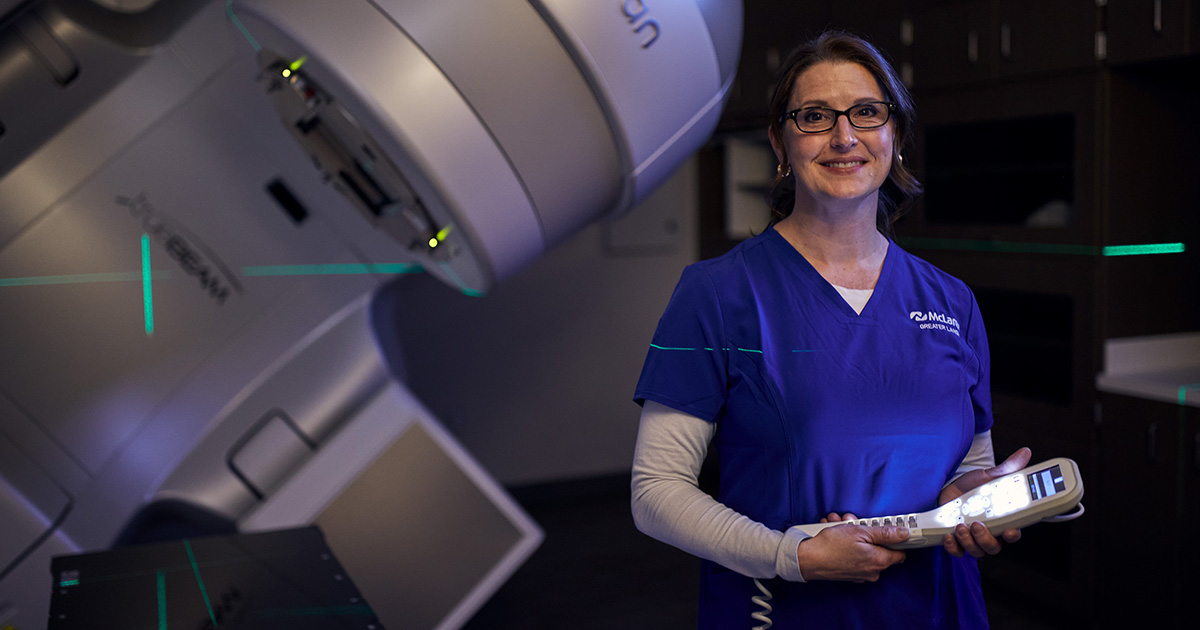
Radiation therapy is a highly effective treatment for cancers including in the breast, abdomen, and lungs, but treatment in these areas also exposes the nearby heart to radiation. Karmanos Cancer Institute at McLaren Greater Lansing is using innovative techniques that help prevent damage to the heart.
Deep Inspiration Breath Hold (DIBH)
“DIBH consists of taking a deep breath and holding it for 15-20 seconds throughout the treatment,” said Lisa Mulder, radiation therapist at Karmanos Cancer Institute. “Through this method, it lifts the chest up and pulls the heart away, protecting it further from the radiation.”
This state-of-the-art technique provides the utmost accuracy. Using an infrared camera, it monitors the patient’s breathing and the expansion of the chest during DIBH. While the patient is lying on their back for treatment, the radiation therapists instruct the patient to take in a deep breath and hold. If the breath hold is at the appropriate level, treatment is initiated. While the treatment is underway, if at any time the patient’s breath hold falls outside the set level the machine will automatically turn off. For example, if the patient coughs, or must start breathing, the radiation will instantly stop.
“It’s very important to keep everything consistent when we are treating the patient, and with this technology we are able to target precisely where we need to treat at the optimum level of their deep breath,” said Mulder.
Prior to DIBH techniques, the heart was more vulnerable to being exposed, especially for those who had breast cancer on the left side (heart-side). The traditional technique for treating left-side breast cancer used to increase the risk of long-term damage to the heart and heart disease.
Prone Position
If the patient cannot lay on their back or cannot hold their breath, a special treatment device is used to treat the patient lying on their stomach (prone). With this setup, the breast that is being treated is suspended from the patient’s body, separating the breast tissue from the heart.
Stereotactic Treatment for Breast Cancer
Typically used for other forms of cancer, such as brain and lung cancers, stereotactic body radiation therapy (SBRT) is now being used to treat breast cancers and is also used as a method in sparing the heart tissues during the treatment process.
"For early breast cancers, stereo-tactic treatment allows us to treat the patient in just five treatments, whereas before the patient had to be treated daily for up to six weeks,” said Dr. Christian Hyde, radiation oncologist at Karmanos Cancer Institute. “We are treating a much smaller and precise area, so we can shorten the course, and the cure rate is excellent: over 95% at five years. Studies show the shorter course has fewer side effects and better cosmetic results."
Proton Therapy
For patients who can’t use some of the heart-sparing techniques available in Lansing or have a hard time lying facing down (prone) or with deep breath hold, proton therapy is another way to avoid the heart.
"Through the Karmanos Cancer Network, patients in Lansing also have access to the McLaren Proton Therapy Center in Flint, which is the largest and newest proton therapy center in Michigan," said Dr. Hyde. "Proton beams are very focused and can be programmed to stop precisely in the part of the body holding the patient’s cancer. The proton beams can stop on a dime, which makes it different from X-rays that go in one side and out the other."
Proton therapy has no exit dose. It enters the patient, treats the tumor, and then stops without exiting out the other side of the patient. “This means the same chance of tumor control can be achieved using only one-third as much dose to the body. Because protons stop where we tell them to, we can better avoid damage to critical organs like the heart, esophagus, bowel, and bladder,” said Dr. Hyde.
Both Dr. Hyde and Dr. Brian Yeh, physicians who practice in Lansing, have extra fellowship training in the use of proton therapy. Consultation with an experienced proton specialist is the best way to decide what type of treatment is most likely to succeed. "It's not like the old days where radiation was radiation and it always entailed a long course. We now have lots of options," notes Dr. Hyde.
For more information about radiation therapy at Karmanos Cancer Institute, click here.
For more articles on health and wellness, click here.